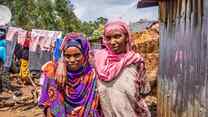
Every year on November 20, World Children's Day is celebrated to commemorate the adoption of the 1959 Declaration on the Rights of the Child. This international agreement recognized numerous rights for children, including access to quality education, protection, good nutrition and healthcare.
The IRC upholds these rights by prioritizing the needs of children throughout our programming and advocating for the rights of children, especially those living in crisis contexts.
This World Children’s Day, we examine five crises impacting children around the world and how we are addressing them.
Over 110 million people worldwide are displaced — half are children
Children are especially vulnerable to abuse and exploitation during times of conflict. Although international humanitarian law has established protections for children during these periods of turmoil, nearly 3,000 children were killed across 24 conflict-affected countries in 2022.
The conflict in Gaza has been catastrophic for children. Over 4,500 have been killed and an estimated 1,500 children are missing, either trapped or dead under the rubble. Thirty Israeli children remain held hostage inside Gaza. In addition to physical harm, more than 625,000 children do not have access to safe learning. Over half of Gaza's schools have been damaged in attacks and all are closed due to the conflict. Hundreds of thousands of children in Gaza have witnessed extensive destruction and displacement, and urgently need mental health and psychosocial support.
Children who are forced to flee their homes due to conflict often find themselves in a state of uncertainty for extended periods of time. Refugees, on average, spend 20 years without a stable home, while internally displaced persons experience an average of 10 years of displacement. Many children are born and raised in refugee and internally displaced settlements that often lack access to proper health and education services.
Difficulties integrating into a new society and discrimination create barriers for refugees, preventing children from overcoming displacement trauma even after resettlement.
The IRC recognizes the importance of protecting displaced children. Our services in conflict-affected regions like Afghanistan and Ukraine provide immediate support to children fleeing conflict. In 2022, our Refugee, Asylum and Integration (RAI) teams provided support to more than 300,000 people in the United States and Europe through asylum and protection programs, economic empowerment services and by supporting the resettlement of refugees.

Read more about Ameera’s story.
Climate change is jeopardizing children’s futures
Climate change is affecting lives worldwide. Despite contributing little to carbon emissions, people — especially children — in conflict-affected and climate-vulnerable communities are disproportionately impacted by climate change.
For example, although Somalia, Ethiopia and Kenya collectively emit just 0.1 percent of total global CO2 emissions, East African communities have been grappling with a humanitarian crisis catalyzed by a series of climatic shocks. Severe and prolonged droughts have affected over 40 million people, decimating the availability of safe water, crops and livestock. Now, volatile storms and flooding are battering the region, intensifying the needs of climate-vulnerable communities. More than 23.8 million people lack access to safe water and 2.2 million face destructive landslides and floods.
The consequences on child health have been severe. Drought leads to an increase in malnutrition rates, particularly among children in conflict-affected communities. Floods contaminate water sources with sewage, leaving them unsafe and increasing the risk that waterborne diseases may spread. Nearly 300,000 children in Libya continue to face an increased risk of diarrhea and cholera as well as dehydration and malnutrition after intense flooding washed away entire neighborhoods. Children who were separated from their families face increased risks of exploitation and violence. And children’s education is disrupted by continued displacement driven by climate.
The IRC helps communities respond to the changing climate with efforts in seed security and climate-resilient agriculture, building sustainable livelihoods and fighting impacts like hunger. With partners in Nigeria, the IRC has piloted a groundbreaking study that identified the positive impacts of delivering cash assistance to vulnerable communities before climate disasters.
Find out which 10 countries are at risk of climate disaster.

Malnutrition affects over 45 million children each year worldwide
Malnutrition can take many forms, but acute malnutrition is the most dangerous for children. It weakens their immune systems, making even mild illnesses like diarrhea or measles potentially fatal. Tragically, up to two million children die each year due to acute malnutrition. Even if they recover, many children who experience acute malnutrition suffer setbacks in their physical and cognitive development.
Several factors — including climate change, conflict and economic crises — can increase rates of hunger and malnutrition.
Currently, children with severe acute malnutrition and moderate acute malnutrition are treated with different products through different programs, which are distributed and administered by different international organizations. This strategy is overly complex and hinders efforts to meet a mounting global hunger crisis for which quick and direct action is needed to save lives.
Despite the growing scale and complexity of the global child malnutrition crisis, a proven and simple solution exists.
The IRC has developed a malnutrition treatment protocol that empowers community health workers to diagnose and treat malnourished children with high-protein peanut paste. This simplified approach also treats children with moderate and severe acute malnutrition the same - the status quo approach treats these groups of malnourished children differently without clinical justification, which creates needless bureaucracy and costs.
The IRC’s streamlined approach is more efficient, cost-effective and impactful. A study of over 27,000 cases in Mali found this approach to be 92% effective while a 2018 study demonstrated a 98% recovery amongst treated children.
The IRC estimates that less than $2 billion USD —equivalent to 0.02% of global health spending— can close the wasting treatment gap in the 15 countries most affected by food and nutrition crises. Closing this gap provides the chance to save the lives of up to two million children.
Learn how world leaders can address the global child malnutrition crisis.

Crises create barriers to education
The Declaration on the Rights of the Child recognizes education as a crucial right. However, 250 million children and youth worldwide are currently out of school. Tens of millions of children who are in school are not developing key basic literacy and numeracy skills. If steps are not taken to both strengthen access to schooling worldwide and ensure the education students receive once they’re in school is impactful and effective, an estimated 835 million children will lack the necessary skills to contribute to the workforce by 2035.
The IRC is a global leader in providing customized education support to assist communities affected by crises. Our educational programming includes Ahlan Simsim, the largest early childhood initiative intervention in the history of humanitarian response reaching over 2 million children and with 60 local partners across the Middle East, and the PlayMatters program, which brings learning through play opportunities to 800,000 children across Ethiopia, Tanzania and Uganda.
In continuation of the IRC’s commitment to innovation, we are developing new solutions to tackle the most pressing matters affecting children — including education. The IRC is leveraging artificial intelligence (AI) to create remote learning opportunities for children affected by crises.

Mental health needs are high amongst children affected by crisis
Enduring crises is challenging for everyone. 1 in 5 individuals affected by conflict will experience mild, moderate, or severe mental health conditions, which may include depression, anxiety, post-traumatic stress disorder, bipolar disorder or schizophrenia.
Children who experience crises during a critical stage of growth are prone to experience long-term psychological setbacks.
Crises such as floods or wars can cause significant disruptions to health facilities and leave children without access to medical services or support networks. Low-income countries are often the most severely affected by such crises. Unfortunately, they do not have strong mental health care systems in place.
In low-income countries, there is only one mental health worker for every 100,000 people, which is a stark contrast to high-income countries that have over 60 mental health workers per 100,000 people.
The IRC acknowledges that mental health is critical to overall well-being. We work directly with crisis-affected communities and partner organizations to meet the mental health needs of vulnerable populations.
We provide children with safe spaces, psychosocial support, counseling, primary health care and other services to ensure they can receive care, from the earliest stages of a mental health crisis through recovery. The IRC is also piloting the InforMH program in Jordan to bridge a mental health treatment gap in the country and support the mental health care of children and their families who are affected by crisis. This program uses AI to assess the mental health needs of users and subsequently recommends tailored services that help users address mental health challenges.
Learn more about InforMH and how the IRC is addressing mental health needs.

*Pseudonym used for privacy



